Grip Stabilization through Independent Finger Tactile Feedback Control
Abstract
1. Introduction
2. Modular Tactile Sensing-Based Grip Stabilization
2.1. Slip Prediction
2.2. Grip Force Control
2.3. From Single-Finger to Multi-Finger Grip Force Control
3. Experimental Evaluation
3.1. Experimental Setup: Testing Platform and Tactile Sensors
3.2. Test and Training Objects
3.3. Tactile Training
3.4. Grip Stabilization Evaluation
3.4.1. Multi-Finger Grip Stabilization with Independent Finger Control
3.4.2. Stabilization Success Rates with Independent Finger Control
3.4.3. Grip Stabilization under External Perturbations
3.4.4. Master–Slave Operation
3.4.5. Current Limitations
4. Conclusion and Discussion
4.1. Summary of the Contribution
4.2. Recognized Shortcomings
4.3. Future Work
Author Contributions
Funding
Acknowledgments
Conflicts of Interest
References
- Hertkorn, K.; Roa, M.A.; Borst, C. Planning in-hand object manipulation with multifingered hands considering task constraints. In Proceedings of the IEEE International Conference on Robotics and Automation (ICRA), Karlsruhe, Germany, 6–10 May 2013; pp. 617–624. [Google Scholar]
- Chavan-Dafle, N.; Holladay, R.; Rodriguez, A. Planar In-Hand Manipulation via Motion Cones. Int. J. Robot. Res. 2019, 39, 163–182. [Google Scholar] [CrossRef]
- Shi, J.; Woodruff, J.Z.; Umbanhowar, P.B.; Lynch, K.M. Dynamic in-hand sliding manipulation. IEEE Trans. Robot. 2017, 33, 778–795. [Google Scholar] [CrossRef]
- Costanzo, M.; De Maria, G.; Natale, C. Two-Fingered In-Hand Object Handling Based on Force/Tactile Feedback. IEEE Trans. Robot. 2019, 36, 157–173. [Google Scholar] [CrossRef]
- Sundaralingam, B.; Hermans, T. Relaxed-rigidity constraints: In-grasp manipulation using purely kinematic trajectory optimization. Planning 2017, 6, 7. [Google Scholar]
- Bohg, J.; Morales, A.; Asfour, T.; Kragic, D. Data-driven grasp synthesis—a survey. IEEE Trans. Robot. 2014, 30, 289–309. [Google Scholar] [CrossRef]
- Pinto, L.; Gupta, A. Supersizing self-supervision: Learning to grasp from 50k tries and 700 robot hours. In Proceedings of the IEEE International Conference on Robotics and Automation (ICRA), Stockholm, Sweden, 16–21 May 2016; pp. 3406–3413. [Google Scholar]
- Yahya, A.; Li, A.; Kalakrishnan, M.; Chebotar, Y.; Levine, S. Collective robot reinforcement learning with distributed asynchronous guided policy search. In Proceedings of the IEEE/RSJ International Conference on Intelligent Robotics and Systems (IROS), Vancouver, BC, Canada, 24–28 September 2017; pp. 79–86. [Google Scholar]
- Calandra, R.; Owens, A.; Upadhyaya, M.; Yuan, W.; Lin, J.; Adelson, E.H.; Levine, S. The Feeling of Success: Does Touch Sensing Help Predict Grasp Outcomes? In Proceedings of the Conference on Robot Learning, Mountain View, CA, USA, 13–15 November 2017; pp. 314–323. [Google Scholar]
- Van Hoof, H.; Hermans, T.; Neumann, G.; Peters, J. Learning robot in-hand manipulation with tactile features. In Proceedings of the IEEE/RAS International Conference on Humanoid Robots (Humanoids), Seoul, Korea, 3–5 November 2015; pp. 121–127. [Google Scholar]
- Prattichizzo, D.; Malvezzi, M.; Gabiccini, M.; Bicchi, A. On motion and force controllability of precision grasps with hands actuated by soft synergies. IEEE Trans. Robot. 2013, 29, 1440–1456. [Google Scholar] [CrossRef]
- Kazemi, M.; Valois, J.S.; Bagnell, J.A.; Pollard, N. Robust Object Grasping Using Force Compliant Motion Primitives. In Proceedings of the Robotics: Science and Systems Conference (RSS), Sydney, Australia, 9–13 July 2012; pp. 177–185. [Google Scholar]
- Andrychowicz, O.M.; Baker, B.; Chociej, M.; Jozefowicz, R.; McGrew, B.; Pachocki, J.; Petron, A.; Plappert, M.; Powell, G.; Ray, A.; et al. Learning dexterous in-hand manipulation. Int. J. Robot. Res. 2020, 39, 3–20. [Google Scholar] [CrossRef]
- Akkaya, I.; Andrychowicz, M.; Chociej, M.; Litwin, M.; McGrew, B.; Petron, A.; Paino, A.; Plappert, M.; Powell, G.; Ribas, R.; et al. Solving Rubik’s Cube with a Robot Hand. arXiv 2019, arXiv:1910.07113. [Google Scholar]
- Bekiroglu, Y.; Laaksonen, J.; Jorgensen, J.A.; Kyrki, V.; Kragic, D. Assessing grasp stability based on learning and haptic data. IEEE Trans. Robot. 2011, 27, 616–629. [Google Scholar] [CrossRef]
- Dang, H.; Allen, P.K. Stable grasping under pose uncertainty using tactile feedback. Auton. Robot. 2014, 36, 309–330. [Google Scholar] [CrossRef]
- Madry, M.; Bo, L.; Kragic, D.; Fox, D. ST-HMP: Unsupervised spatio-temporal feature learning for tactile data. In Proceedings of the IEEE International Conference on Robotics and Automation (ICRA), Hong Kong, China, 31 May–7 June 2014; pp. 2262–2269. [Google Scholar]
- Li, M.; Bekiroglu, Y.; Kragic, D.; Billard, A. Learning of grasp adaptation through experience and tactile sensing. In Proceedings of the IEEE/RSJ International Conference on Intelligent Robotics and Systems (IROS), Chicago, IL, USA, 14–18 September 2014; pp. 3339–3346. [Google Scholar]
- Romano, J.M.; Hsiao, K.; Niemeyer, G.; Chitta, S.; Kuchenbecker, K.J. Human-inspired robotic grasp control with tactile sensing. IEEE Trans. Robot. 2011, 27, 1067–1079. [Google Scholar] [CrossRef]
- Levine, S.; Pastor, P.; Krizhevsky, A.; Ibarz, J.; Quillen, D. Learning hand-eye coordination for robotic grasping with deep learning and large-scale data collection. Int. J. Robot. Res. 2017, 37, 4–5. [Google Scholar] [CrossRef]
- Saxena, A.; Driemeyer, J.; Ng, A.Y. Robotic Grasping of Novel Objects using Vision. Int. J. Robot. Res. 2018, 27, 157–173. [Google Scholar] [CrossRef]
- Mahler, J.; Liang, J.; Niyaz, S.; Laskey, M.; Doan, R.; Liu, X.; Ojea, J.A.; Goldberg, K. Dex-Net 2.0: Deep Learning to Plan Robust Grasps with Synthetic Point Clouds and Analytic Grasp Metrics. arXiv 2017, arXiv:1703.09312. [Google Scholar]
- Ciocarlie, M.T.; Allen, P.K. Hand posture subspaces for dexterous robotic grasping. Int. J. Robot. Res. 2009, 28, 851–867. [Google Scholar] [CrossRef]
- Ozawa, R.; Tahara, K. Grasp and dexterous manipulation of multi-fingered robotic hands: A review from a control view point. Adv. Robot. 2017, 31, 1030–1050. [Google Scholar] [CrossRef]
- Chen, W.; Khamis, H.; Birznieks, I.; Lepora, N.F.; Redmond, S.J. Tactile sensors for friction estimation and incipient slip detection—Toward dexterous robotic manipulation: A review. IEEE Sens. J. 2018, 18, 9049–9064. [Google Scholar] [CrossRef]
- Johansson, R.S.; Flanagan, J.R. Coding and use of tactile signals from the fingertips in object manipulation tasks. Nat. Rev. Neurosci. 2009, 10, 345–359. [Google Scholar] [CrossRef]
- Edin, B.B.; Westling, G.; Johansson, R.S. Independent control of human finger-tip forces at individual digits during precision lifting. J. Physiol. 1992, 450, 547–564. [Google Scholar] [CrossRef]
- Burstedt, M.; Edin, B.B.; Johansson, R.S. Coordination of fingertip forces during human manipulation can emerge from independent neural networks controlling each engaged digit. Exp. Brain Res. 1997, 117, 67–79. [Google Scholar] [CrossRef]
- Flanagan, J.R.; Burstedt, M.K.; Johansson, R.S. Control of fingertip forces in multidigit manipulation. J. Neurophysiol. 1999, 81, 1706–1717. [Google Scholar] [CrossRef] [PubMed]
- Manis, R.P.; Santos, V.J. Independent digit contributions to rotational manipulation in a three-digit pouring task requiring dynamic stability. Exp. Brain Res. 2015, 233, 2195–2204. [Google Scholar] [CrossRef] [PubMed]
- Klatzky, R.; Bajcsy, R.; Lederman, S.L. Object exploration in one and two fingered robots. In Proceedings of the IEEE International Conference on Robotics and Automation (ICRA), Raleigh, NC, USA, 31 March–3 April 1987. [Google Scholar]
- Bicchi, A.; Salisbury, J.K.; Dario, P. Augmentation of grasp robustness using intrinsic tactile sensing. In Proceedings of the IEEE International Conference on Robotics and Automation (ICRA), Scottsdale, AZ, USA, 14–19 May 1989; pp. 302–307. [Google Scholar]
- Veiga, F.; Peters, J.; Hermans, T. Grip Stabilization of Novel Objects using Slip Prediction. IEEE Trans. Haptic 2018, 2, 531–542. [Google Scholar] [CrossRef] [PubMed]
- Liaw, A.; Wiener, M. Classification and regression by randomForest. R News 2002, 2, 18–22. [Google Scholar]
- Pang, X.D.; Tan, H.Z.; Durlach, N.I. Manual discrimination of force using active finger motion. Percept. Psychophys. 1991, 49, 531–540. [Google Scholar] [CrossRef] [PubMed]
- Wettels, N.; Parnandi, A.R.; Moon, J.H.; Loeb, G.E.; Sukhatme, G.S. Grip control using biomimetic tactile sensing systems. IEEE/ASME Trans. Mechatron. 2009, 14, 718–723. [Google Scholar] [CrossRef]
- Chen, Z.; Lii, N.Y.; Wimböck, T.; Fan, S.; Liu, H. Experimental evaluation of Cartesian and joint impedance control with adaptive friction compensation for the dexterous robot hand DLR-HIT II. Int. J. Humanoid Robot. 2011, 8, 649–671. [Google Scholar] [CrossRef]
- Calli, B.; Singh, A.; Walsman, A.; Srinivasa, S.; Abbeel, P.; Dollar, A.M. The YCB object and model set: Towards common benchmarks for manipulation research. In Proceedings of the IEEE International Conference on Advanced Robotics (ICAR), Istanbul, Turkey, 27–31 July 2015; pp. 510–517. [Google Scholar]
- Burstedt, M.K.; Flanagan, J.R.; Johansson, R.S. Control of grasp stability in humans under different frictional conditions during multidigit manipulation. J. Neurophysiol. 1999, 82, 2393–2405. [Google Scholar] [CrossRef]
- Melchiorri, C. Slip detection and control using tactile and force sensors. IEEE/ASME Trans. Mechatron. 2000, 5, 235–243. [Google Scholar] [CrossRef]
- Johansson, R.S.; Westling, G. Signals in tactile afferents from the fingers eliciting adaptive motor responses during precision grip. Exp. Brain Res. 1987, 66, 141–154. [Google Scholar] [CrossRef]
- Häger-Ross, C.; Cole, K.J.; Johansson, R.S. Grip-force responses to unanticipated object loading: Load direction reveals body-and gravity-referenced intrinsic task variables. Exp. Brain Res. 1996, 110, 142–150. [Google Scholar] [CrossRef] [PubMed]
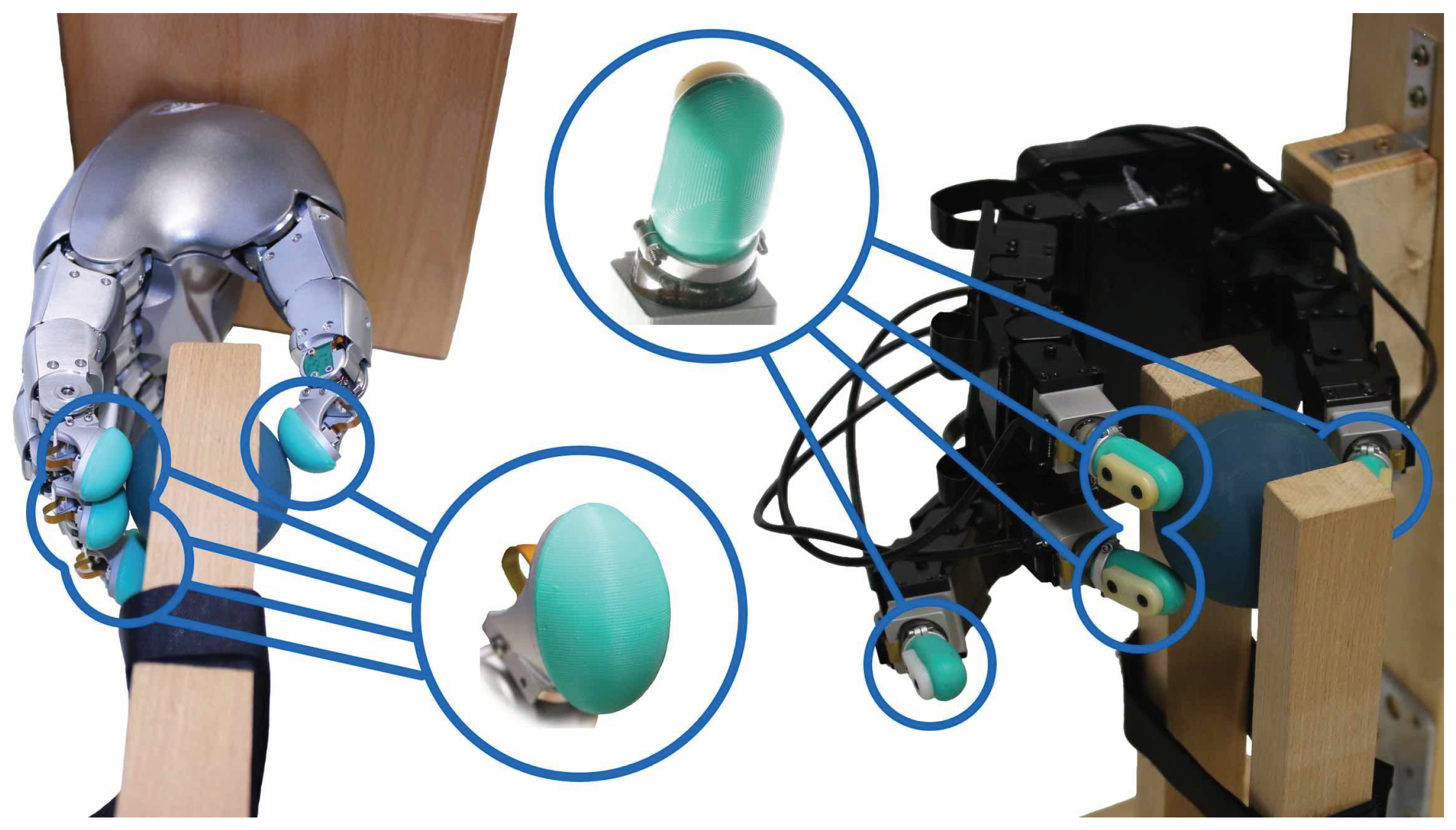

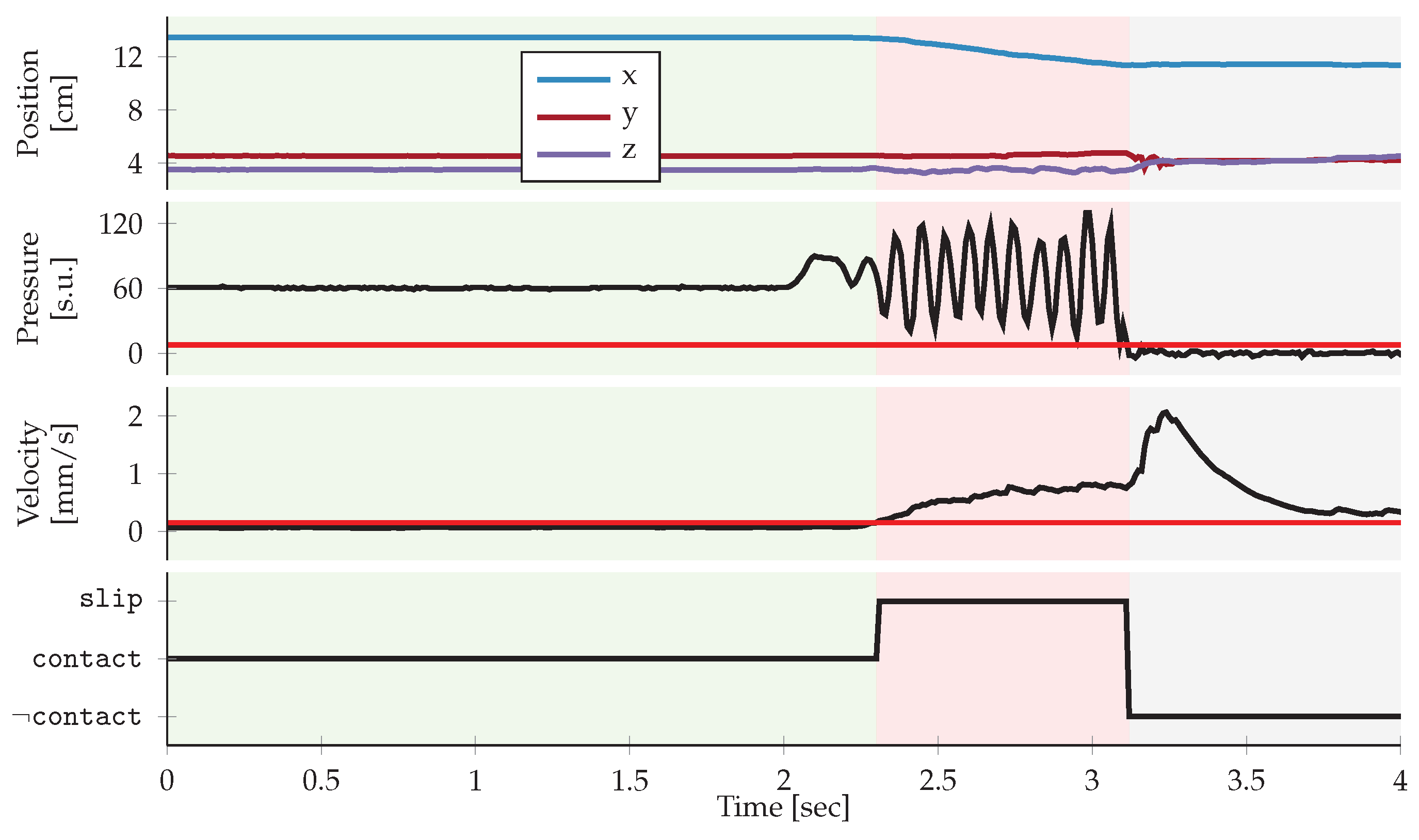
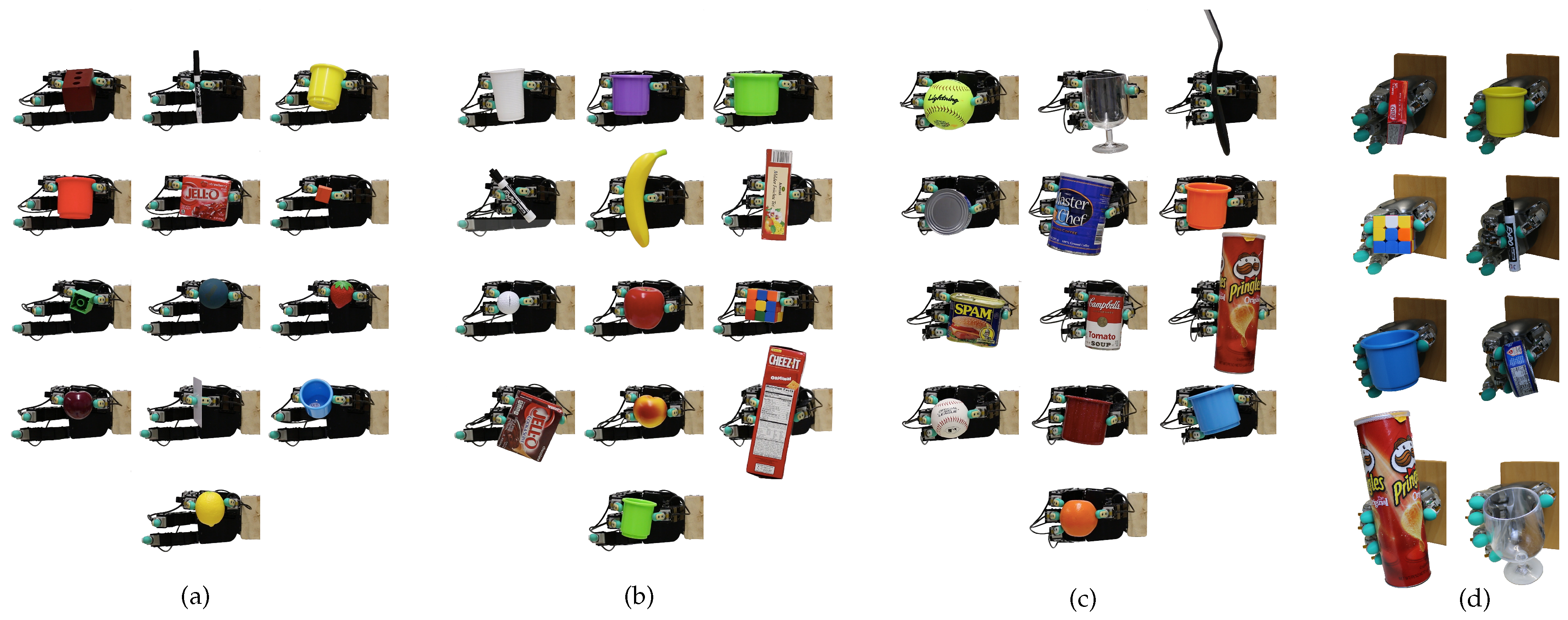

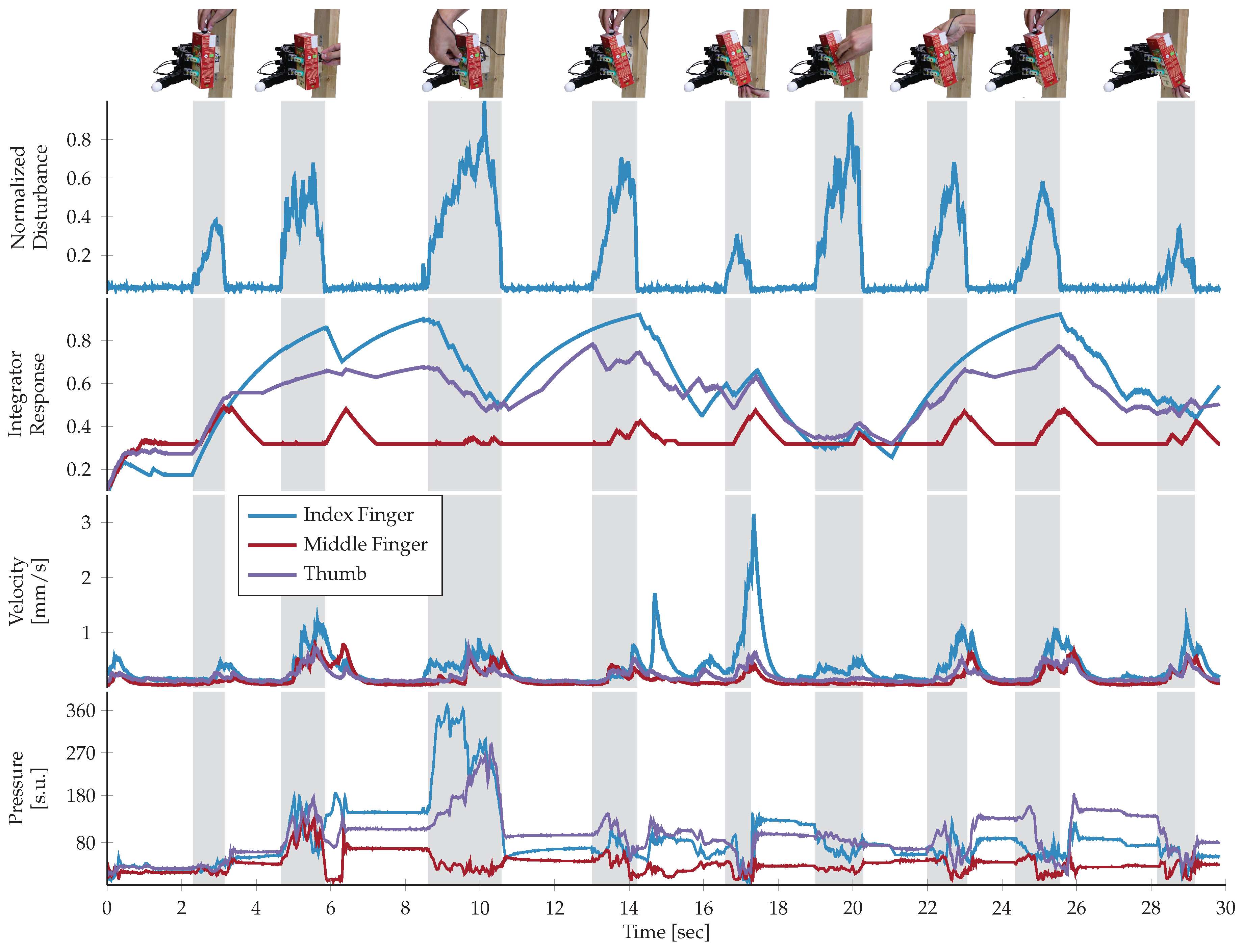

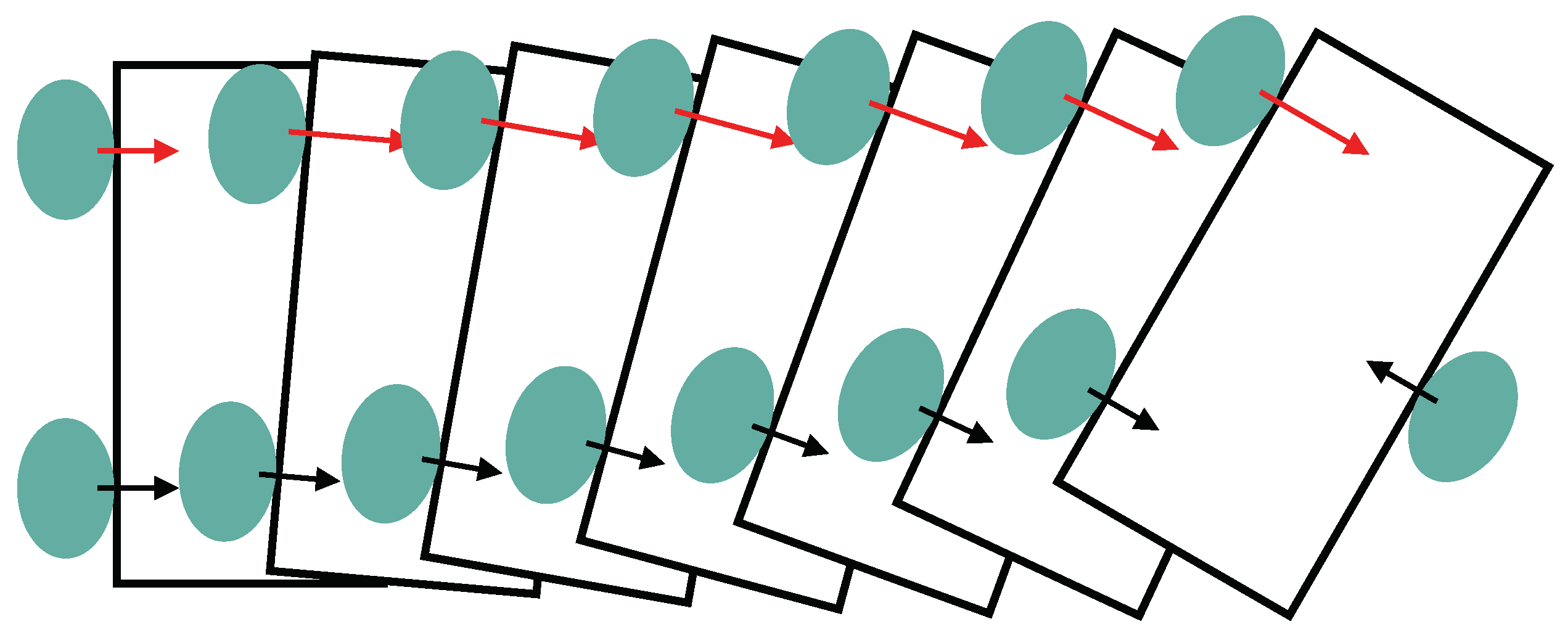
| Two-Finger Grasp | |||
| Card | Orange Cube | Plum | Red Cup |
| 90% | 100% | 80% | 70% |
| Three-Finger Grasp | |||
| White Plastic Cup | JELL-O Choc | Banana | Apple |
| 90% | 100% | 50% | 60% |
| Four-Finger Grasp | |||
| Glass | Pringles | Spatula | Cheez-It |
| 90% | 80% | 60% | 100% |
© 2020 by the authors. Licensee MDPI, Basel, Switzerland. This article is an open access article distributed under the terms and conditions of the Creative Commons Attribution (CC BY) license (http://creativecommons.org/licenses/by/4.0/).
Share and Cite
Veiga, F.; Edin, B.; Peters, J. Grip Stabilization through Independent Finger Tactile Feedback Control. Sensors 2020, 20, 1748. https://doi.org/10.3390/s20061748
Veiga F, Edin B, Peters J. Grip Stabilization through Independent Finger Tactile Feedback Control. Sensors. 2020; 20(6):1748. https://doi.org/10.3390/s20061748
Chicago/Turabian StyleVeiga, Filipe, Benoni Edin, and Jan Peters. 2020. "Grip Stabilization through Independent Finger Tactile Feedback Control" Sensors 20, no. 6: 1748. https://doi.org/10.3390/s20061748
APA StyleVeiga, F., Edin, B., & Peters, J. (2020). Grip Stabilization through Independent Finger Tactile Feedback Control. Sensors, 20(6), 1748. https://doi.org/10.3390/s20061748






